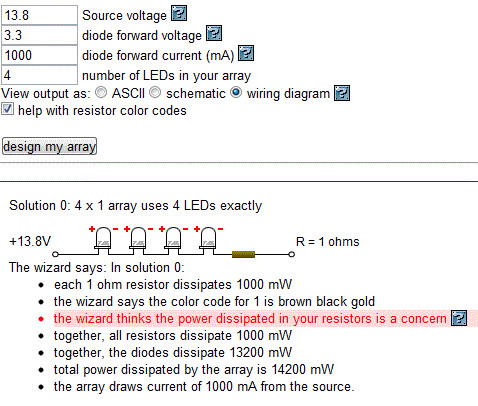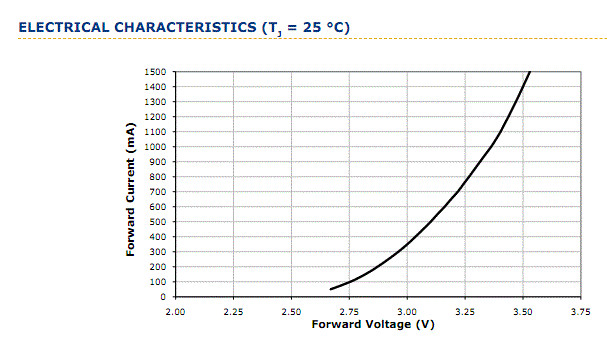samgab
Flashlight Enthusiast
I'm checking for traps and pitfalls with my new project. I have some questions, and appreciate advice.
I had a look at http://led.linear1.org/led.wiz and came up with this:

So I've ordered some 2 Watt 1ohm resistors.
I have a few questions and concerns.

This chart shows that 1Amp current corresponds to 3.3V forward Voltage.
So in a series of 4 that would equate to a 13.2V forward voltage at 1Amp, and I presume that a 1Ohm resistor will equate to a .6V drop?
This circuit will apparently draw 14.2W.
If it works well, I might do some more. This is just testing it out really.
With high power LEDs like this, is it okay to use a constant voltage supply and a calculated resistor like this, or must a constant current supply be used?
Are there any websites with tutorials for this type of thing or useful info?
Cheers,
Sam.
- I have some strips of 40mm x 3mm x 1M aluminium bar stock.
- I've ordered some Cree XP-G LEDs.
- I have a 13.8 V constant DC voltage power supply, which can supply up to 8A of current, or just over 100W of power.
- I've ordered some 1Ohm, 2W resistors.
I had a look at http://led.linear1.org/led.wiz and came up with this:
So I've ordered some 2 Watt 1ohm resistors.
I have a few questions and concerns.
- Will the circuit as described above, connected to a 13.8V constant voltage power supply only draw 1Amp per array?
- What is the best way to attach the LEDs to the aluminium? I thought of thermal adhesive or thermal tape.
- I wonder what size power cable is capable of handling 1Amp Current?
- Is 1Amp a good level to drive the XP-G at?
This chart shows that 1Amp current corresponds to 3.3V forward Voltage.
So in a series of 4 that would equate to a 13.2V forward voltage at 1Amp, and I presume that a 1Ohm resistor will equate to a .6V drop?
This circuit will apparently draw 14.2W.
- Will a 2W power rated resister be sufficient? I think it will, because it will be dissipating 1W, which is only 50% of it's rated capability.
- Will anything special be required to cool the resister... Maybe if I was to mount it to the aluminium using thermal adhesive also?
- I'm thinking of also installing a switch in circuit (rather than just turning off the power supply at it's switch) and a 2A (?) fuse.
- I don't know what kind of switch (prefer illuminated... 12v? 2A? DC?) or what type of fuse... Maybe automotive fuses and switches would be best.
If it works well, I might do some more. This is just testing it out really.
With high power LEDs like this, is it okay to use a constant voltage supply and a calculated resistor like this, or must a constant current supply be used?
Are there any websites with tutorials for this type of thing or useful info?
Cheers,
Sam.
Last edited:

